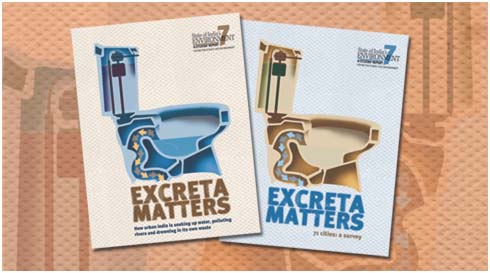India
Environmental knowledge for hydro-meteorological disaster management: Capacity development in disaster risk management
Posted on 03 May, 2012 02:27 PMPoor understanding of the environment – its structure, function, resources, especially at the level of planners and policy makers, have resulted in increasing frequency and intensity of hazards in nature. Understanding of the environment, its processes and resources are important for the early detection of hydro-meteorological hazards, prediction of disaster risk and scenarios and in evolving m
"Excreta Matters" - A profile of the water and sewage situation in 71 Indian cities - A report by the Centre for Science and Environment
Posted on 02 May, 2012 12:24 PMGuset post: Amita Bhaduri

Source: Excreta Matters, Centre for Science and Environment, 2012
People in National capital territory of Delhi are far away from safe drinking water: Role of governance and civil society
Posted on 30 Apr, 2012 09:56 PMPhysicochemical assessment of water quality with respect to remote sensing and GIS techniques - Paper published in the journal Advances in Pure and Applied Chemistry
Posted on 30 Apr, 2012 12:43 PMThe paper informs that current techniques normally used in the country for monitoring and assessment of the quality of water bodies involve in situ measurement and/or the collection of water samples for subsequent laboratory analysis of the chemical, physical and biological characteristics of water.
Draft National Water Policy 2012 and mainstreaming climate change adaptation
Posted on 27 Apr, 2012 01:58 PMClimate change issue is being loudly debated on international level to reduce emission of various gases, and each nation’s responsibility to control the emission.
Treating waste water using natural substances: Sol gel immobilization of humic and fulvic acids using microfibrillated cellulose
Posted on 27 Apr, 2012 01:49 PMHumic acids and fulvic acids - Sol gel immobilization
Humic acids and fulvic acids have been known to remove heavy metals, toxins, viruses and other inorganic matter and convert them to organic matter. These acids can be obtained from dried cowdung by mild alkaline treatment and filtration.
Accelerating agricultural development for inclusive growth: Strategic issues and policy options
Posted on 27 Apr, 2012 01:30 PMArticle Courtesy : Vikalpa, Volume 37, No 1, January-March 2012
Author: Vijay Paul Sharma
Deep multi-aquifer tube wells are responsible for groundwater depletion & global warming: It is curable
Posted on 27 Apr, 2012 08:39 AMAuthor : Yashwant Deora
Deeper multi-aquifer tube wells are responsible for groundwater depletion & global warming - “That is curable”
Citizens voice alarm over recent Supreme Court judgement on interlinking of rivers
Posted on 25 Apr, 2012 10:39 AMThe Supreme Court of India has in its judgment of 27 February 2012 on the interlinking of rivers project, given categorical directions to the Executive Government to implement the ‘project’ as a whole in a time bound manner and has also asked the Centre to appoint a Special Committee to work out the modalities and oversee the implementation of the project.
Critical review of the impacts, challenges, prospects and conflict management for vitally needed inter-linking of rivers in India
Posted on 23 Apr, 2012 12:17 PMGuest post by : Er. Radhey Shyam Goel
1. Introduction